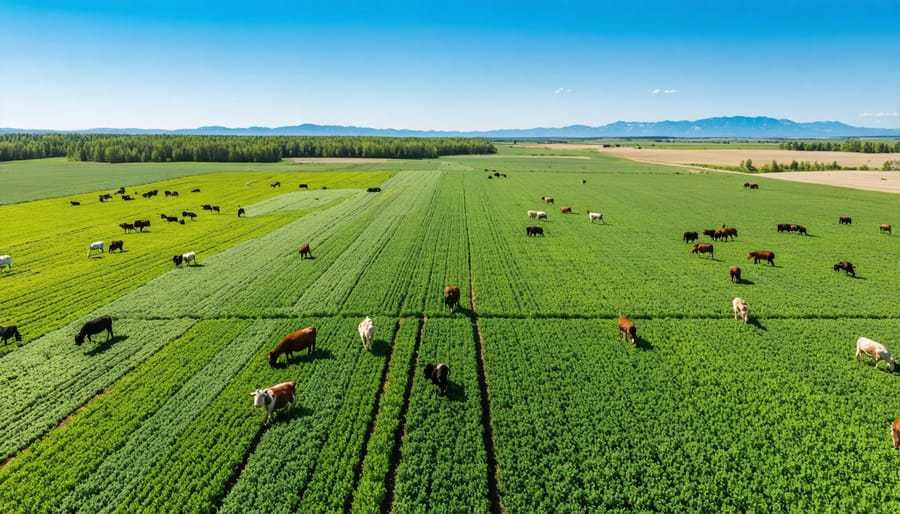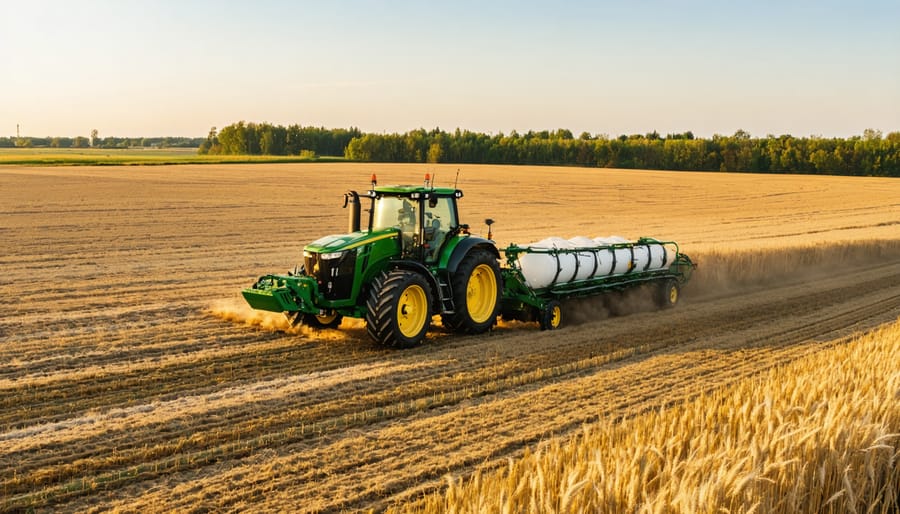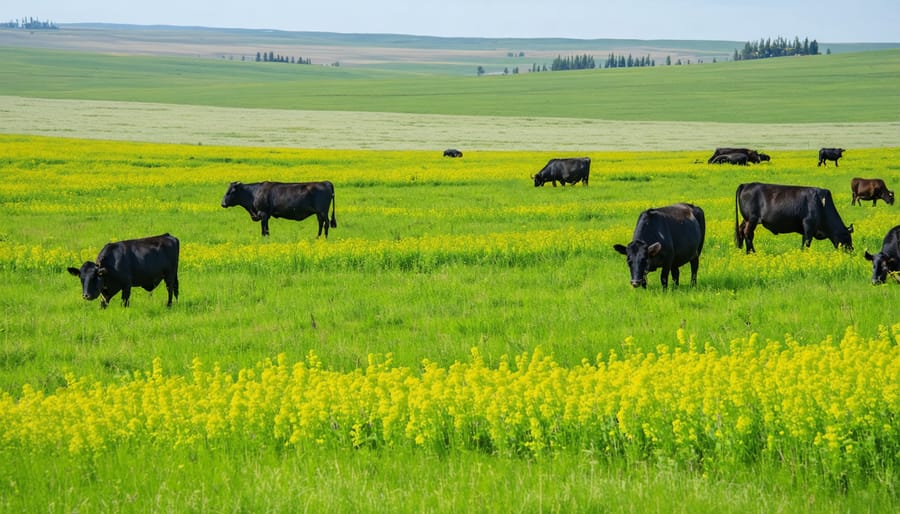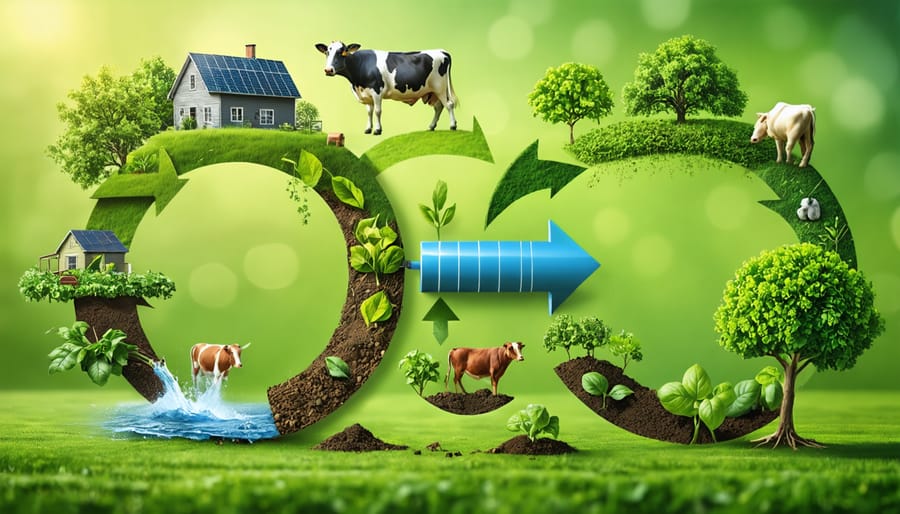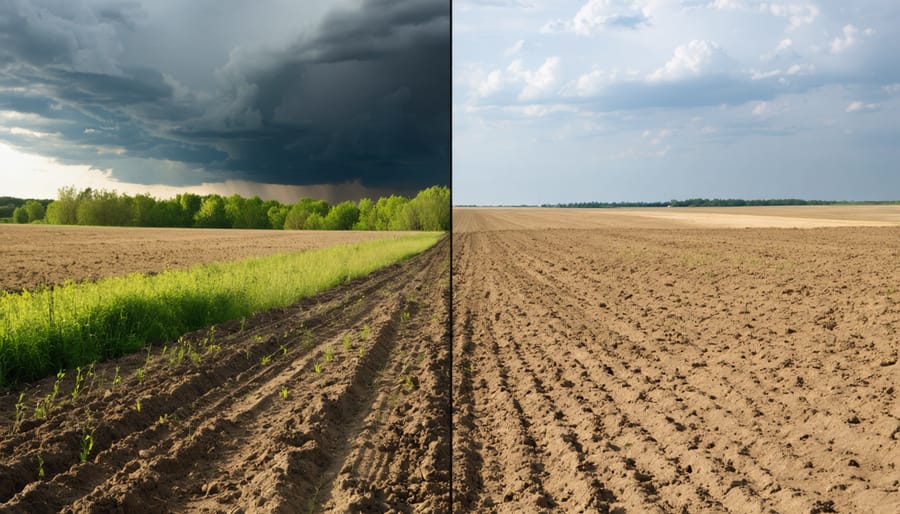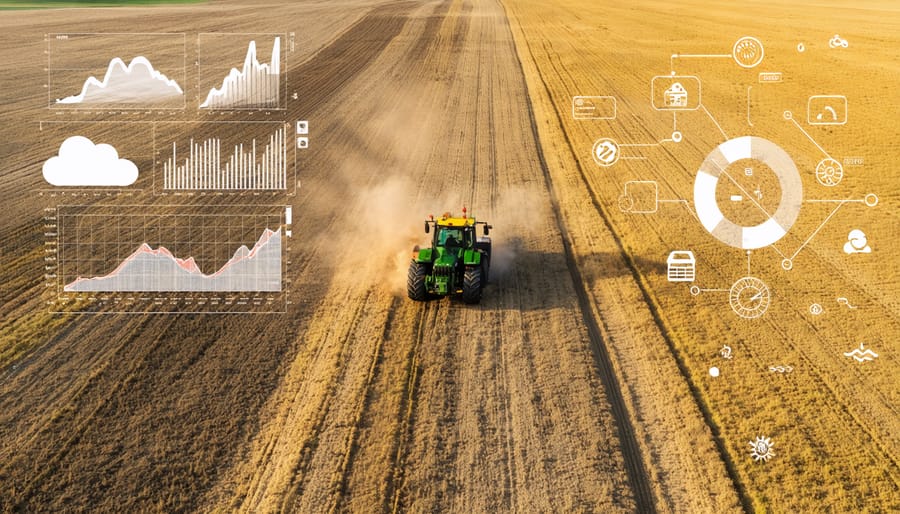Integrate livestock and crops within the same land base to create resilient, profitable farming systems that mirror nature’s circular patterns. This powerful approach to sustainable agricultural practices transforms Canadian farms by maximizing resource efficiency and reducing input costs. Across Alberta’s diverse agricultural landscape, farmers who combine cattle grazing with crop rotation report up to 25% higher soil organic matter and 30% reduced fertilizer needs. By strategically timing livestock grazing with crop cycles, these integrated systems create multiple income streams while building soil health, managing pest pressures naturally, and enhancing farm resilience against climate variability. Recent data from Prairie soil monitoring stations demonstrates that properly managed integrated systems can sequester twice the carbon compared to conventional single-enterprise operations, positioning Canadian farmers at the forefront of climate-smart agriculture.
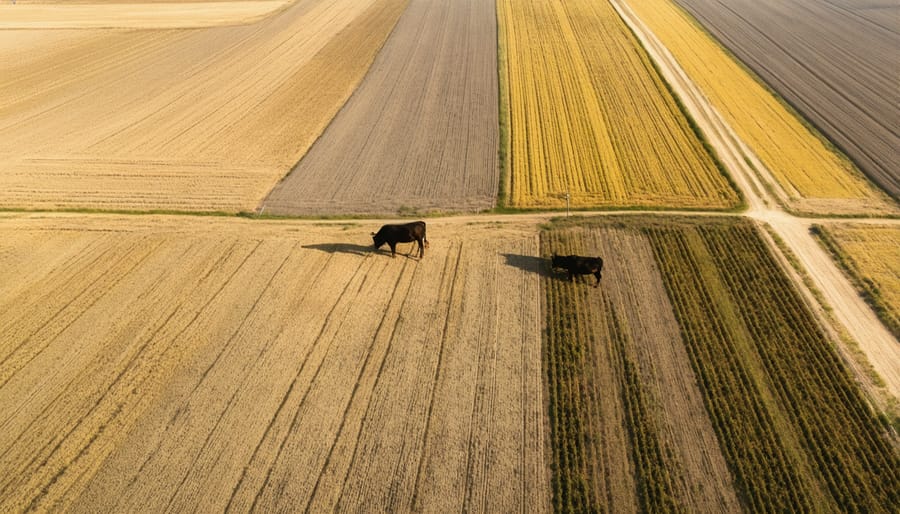
The Synergy Between Crops and Livestock
Nutrient Cycling Benefits
Integrating livestock into crop systems creates a powerful natural fertilization cycle that significantly reduces the need for synthetic fertilizers. When cattle graze crop residues and cover crops, they process plant material into nutrient-rich manure that’s readily available for soil microorganisms. This organic matter improves soil structure and increases its water-holding capacity.
Studies from Alberta research stations show that fields receiving regular manure applications typically require 30-40% less synthetic fertilizer while maintaining comparable yields. The manure provides a balanced mix of nitrogen, phosphorus, and potassium, along with essential micronutrients that synthetic fertilizers often lack.
For example, a farm near Red Deer reported saving approximately $75 per hectare on fertilizer costs after implementing rotational grazing for three years. Beyond the immediate nutrient benefits, livestock integration improves soil organic carbon levels, with local farmers noting increased drought resilience in their manured fields.
This natural nutrient cycling also supports beneficial soil organisms, creating a more robust and self-sustaining agricultural ecosystem that becomes more efficient over time.
Crop Residue Management
Incorporating livestock into crop residue management offers Alberta farmers a natural and profitable solution for post-harvest field maintenance. Cattle, sheep, and other grazing animals can effectively clean up crop residues while contributing to soil health through manure deposits and biological activity.
When livestock graze crop residues, they break down tough plant materials that would otherwise take months to decompose naturally. Their hooves help incorporate organic matter into the soil, while their grazing patterns can reduce weed pressure and volunteer crop growth. This biological approach to residue management can significantly decrease the need for mechanical operations and chemical interventions.
For optimal results, farmers should monitor grazing intensity and timing. In Alberta’s climate, fall grazing works particularly well, allowing animals to utilize residues before winter sets in. Many local producers report success with rotational grazing patterns, moving animals every few days to ensure even distribution of manure and prevent soil compaction.
Calgary-area farmer Mike Johnson shares, “Since introducing cattle to graze our wheat stubble, we’ve seen improved soil structure and reduced our spring field preparation costs by about 30%.”
Economic Advantages for Alberta Farmers
Income Diversification
Incorporating an integrated crop-livestock system creates multiple revenue streams that help buffer against market fluctuations and weather-related risks. By combining agroecological farming methods with livestock operations, Alberta farmers can generate income from various sources throughout the year.
For example, a farm might earn revenue from grain sales in the fall, while also maintaining steady income from livestock products like meat, milk, or eggs. During challenging crop years, livestock operations can help maintain cash flow, while strong crop years can offset periods of lower livestock prices. Additionally, value-added products from both operations create opportunities for premium pricing and direct-to-consumer sales.
Many Alberta farmers report that diversification has helped them weather economic downturns more effectively. The system also reduces dependency on external inputs, as crops and livestock create beneficial cycles that lower operational costs. For instance, grazing livestock on crop residues eliminates the need for separate feed purchases, while manure reduces fertilizer expenses.
This financial resilience is particularly valuable for family farms looking to create sustainable, multi-generational operations in our prairie provinces.
Resource Optimization
Integrated crop-livestock systems excel at maximizing resource efficiency across the farm operation. By combining livestock and crop production, farmers can create closed-loop systems that reduce input costs while improving overall productivity. Manure from livestock provides valuable organic fertilizer for crops, decreasing the need for synthetic fertilizers and improving soil health naturally.
Grazing livestock on crop residues and cover crops helps manage plant material while converting it into marketable protein. This practice reduces the need for mechanical residue management and supplemental feed purchases. In Alberta, many farmers have found success grazing cattle on barley and oat stubble during fall and early winter, making use of resources that would otherwise go unused.
Water efficiency also improves in these integrated systems. Cover crops grazed by livestock help increase soil organic matter and water retention capacity. Equipment and labour resources can be shared between crop and livestock enterprises, spreading fixed costs across more revenue streams. For example, tractors used for field operations can also support hay production and manure spreading.
Local farmers report that this integrated approach typically reduces purchased inputs by 25-30% while maintaining or improving production levels.
Environmental Impact and Sustainability
Soil Health Improvements
Integrating livestock with crop production creates a powerful synergy that dramatically improves soil health over time. When cattle graze crop residues and cover crops, their hooves naturally incorporate organic matter into the soil, while their manure adds valuable nutrients and beneficial microorganisms. Many Alberta farmers report seeing significant improvements in soil structure within just 2-3 years of implementation.
The continuous cycling of nutrients through grazing animals enriches soil organic matter, typically increasing by 0.5-2% over five years. This enhancement leads to better water retention, with improved soils holding up to 25% more moisture than conventionally managed fields. During Alberta’s dry spells, this additional water-holding capacity can make the difference between crop stress and resilience.
Soil compaction, a common concern among farmers, actually decreases under properly managed grazing. The combination of root systems from diverse crops and the periodic presence of livestock creates natural channels for water infiltration and root growth. Testing at several Alberta research stations has shown up to 30% better water infiltration rates in integrated systems compared to crop-only fields.
The biological activity in these soils also increases substantially. Earthworm populations often double or triple, while beneficial fungi and bacteria thrive in the nutrient-rich environment. This enhanced soil ecosystem leads to better nutrient cycling and natural disease suppression, reducing the need for synthetic inputs over time.
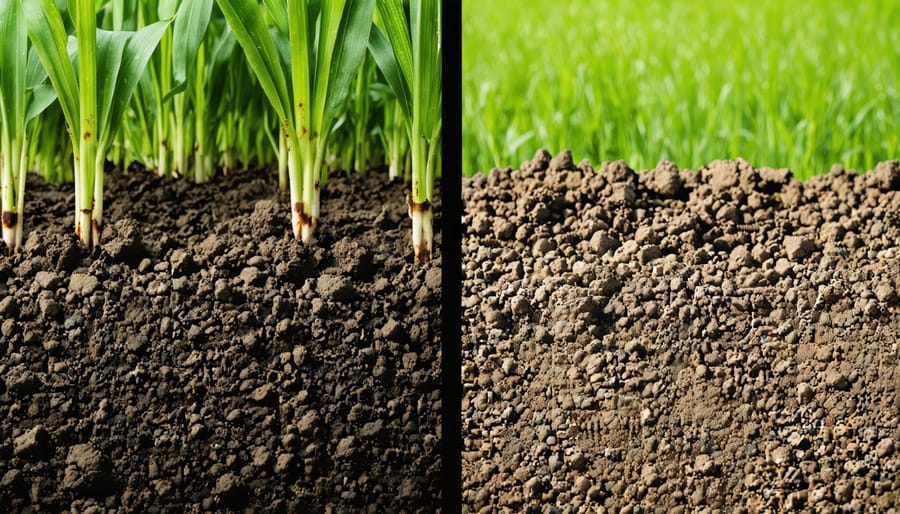
Carbon Sequestration
Integrated crop-livestock systems play a vital role in combating climate change through enhanced carbon sequestration. When crops and livestock work together, they create a natural cycle that helps store more carbon in the soil than conventional farming methods. The combination of grazing animals and diverse crop rotations improves soil organic matter content, which acts as a long-term carbon sink.
In Alberta, farmers implementing these systems have reported significant increases in soil carbon levels over time. Grazing animals help incorporate crop residues into the soil through hoof action and manure deposition, while their selective grazing stimulates plant growth and root development. This increased root mass stores more carbon underground, where it can remain stable for decades.
Research from the University of Alberta shows that integrated systems can sequester between 0.5 to 1.5 tonnes of carbon per hectare annually when properly managed. This is particularly significant for Prairie farmers looking to participate in carbon offset programs while improving their soil health.
The system’s ability to sequester carbon is enhanced through practices like rotational grazing, cover cropping, and reduced tillage. These methods work together to build soil structure, increase biodiversity, and create more resilient agricultural landscapes. For Alberta farmers, this means not only contributing to climate change mitigation but also building more productive and sustainable farming operations that can better withstand environmental stresses.
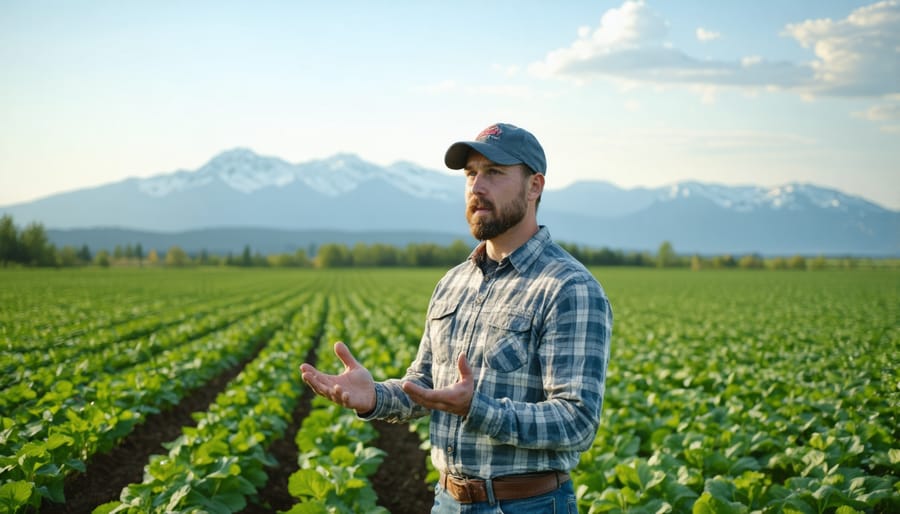
Real Success Stories: Alberta Farm Case Studies
The Smith family from Lethbridge County has been successfully operating an integrated crop-livestock system for over a decade. On their 2,000-hectare farm, they rotate beef cattle through their wheat and barley fields post-harvest, reporting a 30% reduction in fertilizer costs and improved soil health. “The cattle’s grazing patterns and manure distribution have transformed our soil structure,” explains Sarah Smith. “We’ve seen organic matter increase by 2% in just five years.”
In the Peace River region, the Johnson brothers implemented a sheep-grain rotation system that’s become a model for sustainable agriculture. Their 800-hectare operation integrates 500 sheep with canola and wheat production. “Winter grazing on crop residue has cut our feed costs by 40%,” notes Tom Johnson. “Plus, we’ve seen a significant decrease in weed pressure, particularly in our canola fields.”
Near Red Deer, the Martinez family farm showcases how smaller operations can benefit from integration. Their 400-hectare mixed farm combines dairy cattle with corn and barley production. Maria Martinez reports that since implementing their integrated system three years ago, they’ve reduced pesticide use by 35% and increased overall farm revenue by 25%.
The Whitehorse First Nation’s community farm near Edmonton demonstrates how traditional agricultural knowledge enhances modern integrated systems. Their 600-hectare operation combines bison grazing with indigenous grain varieties. “Our approach honors traditional land management while meeting modern market demands,” shares Elder Robert Thunder. The farm has documented a 45% improvement in soil water retention and consistently higher crop yields.
These success stories share common themes: reduced input costs, improved soil health, and enhanced farm resilience. The Alberta Agriculture Extension Service has documented that farms implementing integrated systems typically see a 20-30% reduction in operating costs within the first three years.
Key lessons from these case studies include:
– Start small and scale gradually
– Monitor soil health indicators regularly
– Maintain flexible grazing schedules based on weather and crop conditions
– Build relationships with neighboring farmers for resource sharing
– Keep detailed records of both challenges and successes
These Alberta farmers demonstrate that while transitioning to an integrated system requires careful planning, the long-term benefits to both land and farm economics make it a worthwhile investment.
Implementation Strategies
Getting Started
Starting an integrated crop-livestock system requires careful planning and a phased approach. Begin by assessing your current farm operation, including available land, existing infrastructure, and local climate conditions. Consider starting small, perhaps with a pilot project on 10-20 hectares, to test and refine your management strategies.
First, identify compatible livestock and crop combinations that suit your region. In Alberta, common pairings include cattle with barley or wheat, or sheep with canola stubble. Next, develop a detailed grazing plan that outlines rotation schedules and stocking rates based on your land’s carrying capacity.
Essential infrastructure needs typically include fencing, water sources, and handling facilities. Many Alberta farmers find portable electric fencing and mobile water systems most practical for rotational grazing. Connect with local agricultural extension offices and experienced farmers in your area – they can provide valuable insights and might even offer mentorship opportunities.
Remember to start with realistic goals and maintain detailed records of your progress. This systematic approach will help ensure a smooth transition to integrated farming.
Available Resources and Support
Alberta farmers interested in implementing integrated crop-livestock systems can access numerous support channels and resources. Agricultural Service Boards (ASBs) across the province offer technical assistance and mentorship programs, while the Alberta Farm Sustainability Extension Working Group provides free consultations and workshops. Financial support is available through the Canadian Agricultural Partnership (CAP) program, offering grants for system transitions and infrastructure development.
Local agricultural colleges, including Olds College and Lakeland College, provide specialized training and research opportunities in ecological farming careers. The Alberta Crop Industry Development Fund (ACIDF) supports innovative farming projects, while organizations like Young Agrarians offer networking opportunities and land-linking services for new farmers.
For hands-on learning, the Applied Research Associations across Alberta conduct field demonstrations and provide peer-to-peer learning opportunities through their farmer-led research programs.
Integrated crop-livestock systems represent a powerful opportunity for Canadian farmers to enhance their operations’ sustainability, profitability, and resilience. By combining crop and livestock production, farmers can create efficient nutrient cycles, reduce input costs, and improve soil health while diversifying their income streams. The success stories from Alberta’s farming community demonstrate that these systems are not just theoretical concepts but practical solutions that work in our local conditions. As our agricultural sector faces increasing challenges from climate variability and market uncertainties, the adoption of integrated systems offers a proven path forward. Whether you’re managing a small family farm or a large-scale operation, consider taking the first step toward integration – even starting with a small pilot project can lead to significant benefits for your farm’s future. The growing network of experienced farmers and agricultural professionals across Alberta stands ready to support your transition to this sustainable farming approach.

